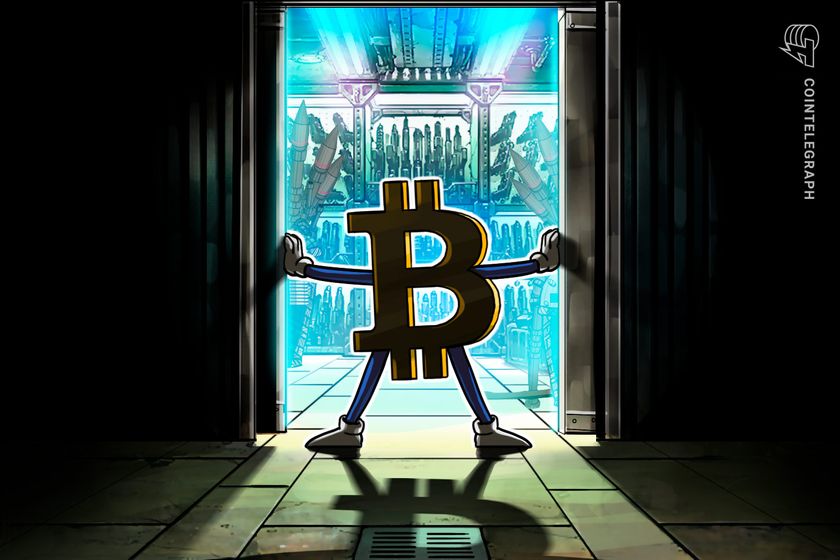ভয় ও লোভ সূচক
শীর্ষ ৭ গেইনার
| ক্রিপ্টোকারেন্সি | ২৪ ঘণ্টার পরিবর্তন |
|---|---|
| 8.67% | |
| 4.89% | |
 Wrapped stETH (wsteth) Wrapped stETH (wsteth) | 4.79% |
 Wrapped eETH (weeth) Wrapped eETH (weeth) | 4.72% |
 WETH (weth) WETH (weth) | 4.71% |
 Ethereum (eth) Ethereum (eth) | 4.7% |
 Rocket Pool ETH (reth) Rocket Pool ETH (reth) | 4.69% |
শীর্ষ ৭ লুজার
| ক্রিপ্টোকারেন্সি | ২৪ ঘণ্টার পরিবর্তন |
|---|---|
 Story (ip) Story (ip) | -6.13% |
| -4.91% | |
 Ethena (ena) Ethena (ena) | -4.02% |
 DeXe (dexe) DeXe (dexe) | -3.61% |
 POL (ex-MATIC) (pol) POL (ex-MATIC) (pol) | -3.16% |
 Internet Computer (icp) Internet Computer (icp) | -2.98% |
 Stacks (stx) Stacks (stx) | -2.86% |


Google will begin enforcing stricter advertising policies for cryptocurrency services in Europe under the Markets in Crypto-Assets (MiCA) framework, the company said in a recent policy update.
The move could be a “double-edged sword” for regulation that may prevent initial coin offering (ICO) frauds, but risks further enforcement gaps, according to legal advisers.
Starting April 23, cryptocurrency exchanges and crypto wallet advertising in Europe must be licensed under Europe’s MiCA framework or under the Crypto Asset Service Provider (CASP) regulation.
Crypto advertisers on Google will also have to comply with “local legal requirements,” including “national-level restrictions or requirements beyond MiCA” and be “certified by Google,” according to a March 24 Google policy announcement.
The new advertising policy will apply to most European countries, including Austria, Belgium, Bulgaria, Croatia, Cyprus, Czech Republic, Denmark, Estonia, Finland, France, Germany, Greece, Hungary, Ireland, Italy, Latvia, Lithuania, Luxemburg, Malta, Netherlands, Poland, Portugal, Romania, Slovakia, Slovenia, Spain and Sweden.
Policy violations “won’t lead to immediate account suspensions,” as a warning will be issued at least seven days before any account suspensions, added Google’s policy update.
The policy shift follows the implementation of the MiCA framework in December 2024, which introduced the first comprehensive regulatory structure for digital assets across the European Union.
Related: EU MiCA rules pose ‘systemic’ banking risks for stablecoins — Tether CEO
Google’s policy seen as double-edged sword
Google’s new crypto advertising requirements present a “double-edged sword” for crypto regulation, according to Hon Ng, chief legal officer at Bitget.
“On one hand, they do enhance investor protection by filtering out unregulated actors,” he told Cointelegraph.
“The MiCA framework’s strict AML/CFT and transparency requirements create a safer ecosystem, reducing scams like the ICO frauds that plagued the industry pre-2023,” he said.
However, Ng warned the policy could be “overly restrictive” without flexible implementation, especially since transition periods for national licensing vary across jurisdictions.
Since Google’s transition period for national licenses varies by country, this may create “temporary gaps in enforcement,” and even bigger challenges around compliance costs, Ng said, adding:
“Smaller exchanges may struggle with MiCA’s capital requirements (15,000–150,000 euros) or the bureaucratic hurdle of dual certification (both Google and local regulators). These measures are a net positive for trust but need flexibility to avoid stifling innovation.”
Related: Most EU banks fail to meet rising crypto investor demand — Survey
Other industry watchers don’t see this as a fundamental change for Google or investor protection.
The updates may be more oriented toward “protecting Google from liability than protecting the investors themselves,” according to Mattan Erder, general counsel at layer-3 decentralized blockchain network Orbs.
“Any impact of this change in Google’s policy is downstream of the regulations themselves. If MiCA or CASP registration turns out to be burdensome, expensive and only accessible to big players, then smaller players will have a lot of difficulty competing in these jurisdictions,” Erder told Cointelegraph.
Magazine: How crypto laws are changing across the world in 2025


Bitcoin (BTC) price has been consolidating within a roughly $3,000 range since April 9 as the 200-day SMA trendline remains a stubborn barrier.
Data from Cointelegraph Markets Pro and Bitstamp shows that BTC price oscillates within a tight range between $83,000 and $86,000, as shown in the chart below.
BTC/USD four-hour chart. Cointelegraph/TradingView
Key factors behind Bitcoin’s flat price action include:
Trump’s mixed signals on technology tariffs.
Buy and sell pressure equilibrium with BTC price trapped between two key levels.
Trump tariffs breed market uncertainty
One significant factor contributing to Bitcoin price flatlining is the White House’s semiconductor and technology tariff inconsistency.
Key points:
Bitcoin price rallied on April 11 after US President Trump announced tariff exemptions for an array of tech products, including smartphones, chips, computers, and semiconductors.
On April 13, Commerce Secretary Howard Lutnick walked back on this announcement, saying that the tariff relief on electronics was temporary.
This was later confirmed by President Trump, who stated that the tariff rate would be announced next week, adding that there would be flexibility for some companies in the sector.
This flip-flopping breeds uncertainty, as tariffs could disrupt supply chains for tech firms, many of which are intertwined with crypto infrastructure like mining and blockchain companies.
According to capital markets commentator The Kobeissi Letter, the "Clarification of Exceptions Under Executive Order 14257" note published by the White House on April 11 did not present a “new list of exemptions.”
Rather, it was a clarification that the “goods were never actually intended to be subject to 145% tariffs,” The Kobeissi Letter explained in an April 14 post on X.
“It appears that the news and most investors, along with customs enforcement themselves, never truly understood what was being tariffed to begin with. This was a complete misunderstanding by almost everyone involved.”
As a result, market participants have taken a wait-and-see approach, as clarity on policy could either ignite a rally or trigger a sell-off.
Related: Trade war vs. record M2 money supply: 5 things to know in Bitcoin this week
BTC price trapped between two key trendlines
Another reason why Bitcoin price remains stuck in limbo is that it trades within two significant levels, as shown in the chart below:
BTC price trades between the 50-day simple moving average (SMA) at $84,400 and the 200-day SMA at $87,500.
This confirms the 200 SMA as resistance and the 50 SMA as support on the daily candle chart.
The value of the RSI close to the midline at 52 suggests that there is a tug-of-war between the bears and the bulls.
Bitcoin needs to break the 200 SMA trendline and confront resistance at the $90,000 psychological level.
Falling below the 50-day SMA will likely lead to a deeper correction.
BTC/USD daily chart. Source: Cointelegraph/TradingView
Meanwhile, the Bitcoin liquidation heatmap reveals heavy ask orders around the 200-day SMA and bid positions just below the 50-day SMA, as shown in the figure below.
This further highlights the liquidity clusters that are currently containing BTC prices within the current market structure.
Bitcoin liquidation heatmap. Source: CoinGlass
This article does not contain investment advice or recommendations. Every investment and trading move involves risk, and readers should conduct their own research when making a decision.


Mantra’s OM (OM) token staged a sharp rebound after plunging 90% over the weekend, following an active response from the project’s team addressing allegations of a rug pull scam.
OM bounces 200% as co-founder addresses concerns
As of April 14, OM was trading for as high as $1.10, almost 200% higher when compared to its post-crash low of $0.37 a day prior.
OM/USDT daily price chart. Source: TradingView
The rebound came after Mantra addressed mounting rug-pull allegations.
Co-founder JP Mullin reassured the community that the project remains active, pointing to the official Telegram group being “still online.”
“We are here and not going anywhere,” Mullin wrote, also sharing a verification address to prove the team's OM token holdings. He attributed the OM’s crash to “reckless forced closures initiated by centralized exchanges.”
Source: JP Mullin
The assurance calmed the OM token sell-off that had obliterated over $5 billion in market capitalization and liquidated $75.88 million worth of futures positions in a day.
Numerous online commentators claimed the Mantra team, reportedly controlling 90% of the token supply, orchestrated the sell-off due to suspicious OM transfers to centralized exchanges right before the crash.
Source: AltcoinGordon
Analyst Ed further alleged that the Mantra team used their OM holdings as collateral to secure high-risk loans on a centralized exchange.
He noted that a sudden change in the platform’s loan risk parameters triggered a margin call, contributing to the token’s sharp decline.
Source: Ed
Exchanges adjust loan risk parameters to manage market volatility and protect themselves from potential insolvency due to falling collateral values. Centralized exchanges like OKX have changed their parameters after Mantra’s tokenomics update in October 2024.
Notably, Mantra doubled the total supply of OM tokens from 888,888,888 to 1,777,777,777 in the said month. It further transitioned from a capped to an uncapped, inflationary model with an initial 8% annual inflation rate.
Source: Wu Blockchain
OKX CEO Star Xu called Mantra a “big scandal,” adding that it would release relevant reports regarding its crash in the coming days.
OM bounce might resemble LUNA’s bull trap
OM’s 200% rebound from its $0.37 low may look impressive, but its structure closely resembles the classic bull trap pattern seen in Terra’s LUNA debacle in May 2022.
OM’s price has crashed below the 50-week exponential moving average (50-week EMA; the red wave) support near $3.25 and is now testing resistance at the 200-week EMA (the blue wave) at around $1.08.
OM/USDT weekly price chart. Source: TradingView
Meanwhile, OM’s weekly relative strength index (RSI) has dropped to 33.31, signaling weakening momentum and increasing the risk of another breakdown.
Related: What is a rug pull in crypto and 6 ways to spot it?
This setup strongly mirrors LUNA’s post-crash behavior. After its sharp decline in May 2022, the price staged a brief recovery but failed to reclaim its 50-week and 200-week moving averages, triggering a deeper and more prolonged downtrend.
LUNA/USD weekly price chart. Source: TradingView
Just like LUNA, OM now faces mounting skepticism despite the temporary bounce, with chartist AmiCatCrypto saying that the Mantra token can plunge 90% within a day after rallying for 100 days.
“If you ask me if bull market is over. Short answer. YES,” she wrote, adding:
“Any gains from this point is considered bounces.”
This article does not contain investment advice or recommendations. Every investment and trading move involves risk, and readers should conduct their own research when making a decision.


Bitcoin (BTC) is holding down the fort as the US trade war rages on into the third week of April.
BTC price action attempts to overcome a long-term resistance trend line without success as trade war concerns dictate traders’ expectations.
Tariffs are the key macroeconomic topic of the week as risk assets brace for potential surprise headlines.
Bitcoin ETFs lost almost $800 million in a week, while Strategy indicates it has purchased the dip.
Despite tariff pressures, the weakness of the US dollar could be a blessing in disguise for Bitcoin and risky assets.
Global M2 money supply is at an all-time high and rising — will Bitcoin follow history and replicate its past?
Bulls battle a key BTC price resistance line
With traders on the lookout for tariff-related volatility this week, BTC price analysis is zooming out.
BTC/USD closed last week up 6.7%, data from Cointelegraph Markets Pro and TradingView confirms.
BTC/USD 1-hour chart. Source: Cointelegraph/TradingView
Next, however, comes the real test — breaking beyond a downward-sloping trend line that has capped the upside for months.
$BTC - #Bitcoin: I’m watching this chart closely. We might be ready. pic.twitter.com/Dtv1jkrzkP
— Crypto Caesar (@CryptoCaesarTA) April 12, 2025
“Rejected at key resistance, following the trendline perfectly,” popular trader Bitbull wrote in his latest post on the topic on X.
“If the breakdown continues, eyes on the $70K-$72K support zone for a possible bounce.”
BTC/USD 12-hour chart. Source: Bitbull/X
Fellow trader and analyst Rekt Capital is also eyeing the trend line as a breakout proves hard to confirm.
“Bitcoin has Daily Closed above the Downtrend. Thus, breakout confirmation is underway,” he told X followers at the weekend.
“However BTC has previously Daily Closed above the Downtrend but failed its retest (a few of the red circles). Retest needs to be successful and it is in progress.”
BTC/USD 1-day chart. Source: Rekt Capital/X
Popular trader AK47 on X posted separate upside and downside BTC price targets depending on the outcome of the trend line retest.
“$BTC might push to $88K—but don’t get too comfy,” he cautioned.
“Could be a fakeout, grabbing liquidity before dipping to $81K for that inverse head & shoulders setup. If that plays out, $95K–$100K isn’t far.”
BTC/USDT 4-hour chart. Source: AK47/X
Tariff talk keeps markets on edge
A quieter week for US macroeconomic data leaves initial jobless claims as the highlight while the ongoing trade war continues to dominate.
With China particularly in focus, risk assets and crypto face flash volatility should more surprises involving trade tariffs surface.
The weekend saw snap relief in that respect as US President Donald Trump announced a pause on tariffs for key tech products. As a result, Bitcoin climbed to eleven-day highs above $86,000.
Subsequent indications that the measures would be temporary then put renewed pressure on stocks’ futures, while BTC/USD retreated to circle $84,000 at the time of writing.
“We think the ‘tariff exemptions’ announced this weekend were originally intended to be temporary,” trading resource The Kobeissi Letter wrote in part of an X reaction.
“The goal was to bring treasury yields back down before resuming the trade war.”
S&P 500 1-hour chart. Source: Cointelegraph/TradingView
Kobeissi suggested that markets had originally considered the move as a signal that the trade war might end completely, only to be disappointed a day later.
“Bonds will likely still rally along with stocks, but uncertainty has only grown. The bond market is king,” it added.
Continuing, trading firm Mosaic Asset agreed that bonds may have been crucial in altering policy trajectory last week.
“It’s the volatility in other areas of the markets like currencies and Treasury bonds that might have forced a quick pivot on trade and tariff policy,” it summarized in the latest edition of its regular newsletter, “The Market Mosaic,” on April 13.
“The uncertainty around tariffs has become a binary and unpredictable event for the stock market. Signs of tensions fuel further downside, while an easing of tensions sends stocks sharply in the other direction.”
Bitcoin ETF outflow “barely registers”
A sign of just how turbulent last week came in the form of net flows from the US spot Bitcoin exchange-traded funds (ETFs).
In one of the worst weeks ever for the ETF products since their debut in early 2024, total outflows passed $750 million.
For network economist Timothy Peterson, however, there is little to worry about.
Zooming out, he noted that even a nine-figure drawdown such as this makes hardly any difference to the overall investment pool that the ETFs have created in little more than a year.
“Last week, US Bitcoin ETFs had their 5th worst week ever (in terms of outflows). Over $700 million. Yet it barely registers as a blip on the chart,” he told X followers.
“That's how big Bitcoin has become. That's how sticky these investments are.”
US spot Bitcoin ETF balances. Source: Timothy Peterson/X
Among major investors seeking to “buy the dip,” meanwhile, is business intelligence firm Strategy (formerly MicroStrategy), whose co-founder Michael Saylor hinted that it was upping its BTC exposure this weekend.
“No Tariffs on Orange Dots,” he wrote in an X post alongside a chart of Strategy’s acquisitions.
Strategy Bitcoin holdings data. Source: Michael Saylor
However, whether Bitcoin will emerge as an attractive proposition for the institutional investor cohort while trade war uncertainty continues is dubious.
A survey by Bank of America in late March showed that respondents overwhelmingly favored gold as a volatility hedge, with 58% choosing it.
“This compares to just 9% for 30-year Treasury Bonds and 3% for Bitcoin,” Kobeissi wrote while reporting on the findings.
“Throw in the US deficit spending crisis and gold quickly becomes the only global safe haven asset.”
BoA survey results. Source: The Kobeissi Letter/X
Dollar dive gives risk assets hope of relief
The US dollar may yet provide some light at the end of the tunnel for wary risk-asset traders this week.
The trade war has taken its toll on the greenback, and when measured against major trading partner currencies, its weakness is plain to see.
The US dollar index (DXY) fell to three-year lows last week and, at the time of writing, is challenging those lows once more.
Markets selling dollar even lower Monday. DXY fell through 100 and also the 2023 low over last few hours, now at lowest in 3 years pic.twitter.com/MJ8wvvJuY2
— David Ingles (@DavidInglesTV) April 14, 2025
While far from constant, Bitcoin’s relationship with dollar strength tends to show that gains occur after major DXY losses — albeit with a delay of several months.
To that end, popular analytics account Bitcoindata21 is eyeing a repeat of events from 2017, resulting in BTC/USD all-time highs at the end of the year.
US dollar index (DXY) fractal. Source: Bitcoindata21/X
Another chart uploaded to X at the weekend showed the relationship between DXY, Bitcoin and the S&P 500, providing ideal conditions for a long-term bottom in the latter.
The last time such a signal came was around one month before the pit of the Bitcoin bear market in late 2022.
“I got 99 problems but the DXY aint 1,” Bitcoindata21 summarized.
BTC/USD vs. S&P 500 vs. DXY chart. Source: Bitcoindata21/X
A bull market rebound in the making?
On longer timeframes, an equally promising trend is playing out for Bitcoin bulls.
Related: Bollinger Bands creator says Bitcoin forming 'classic' floor near $80K
The global M2 money supply, with which Bitcoin price action is positively correlated, is seeking to break out beyond all-time highs.
“Global M2 has remained at an ATH for 3 days in a row,” popular analyst Colin Talks Crypto noted in a dedicated X post on the phenomenon this weekend.
“This is a fantastic sign for what it signals will be coming into risk assets in ~108 days.”
BTC/USD vs. global M2 supply. Source: Colin Talks Crypto/X
The post refers to a chain reaction in which sharp moves in global M2 spark copycat behavior for Bitcoin once the latency period expires.
Before that, however, there may be a final opportunity to “buy the dip.”
“Global M2 (with a 108-day offset) doesn't show a blast-off for another ~2 1/2 weeks, and actually shows a slow bleed into next week until around April 16th or 17th,” Colin Talks Crypto acknowledged.
Earlier this month, the analyst predicted a “big M2 influx” incoming, with a corresponding BTC price rebound beginning in May.
This article does not contain investment advice or recommendations. Every investment and trading move involves risk, and readers should conduct their own research when making a decision.


Why some blockchains die
Blockchains can die from flawed tokenomics, scams, security issues or lack of community and development momentum. Without active participation, even cutting-edge technology gathers dust.
Ever heard of a blockchain that no one uses? It happens more often than you think. While the cryptocurrency space is full of innovation, but not every blockchain finds its tribe. Some are ghost towns with zero transactions, no developers and just a handful of holders stuck with worthless tokens. So, what makes a blockchain go quiet? And can they ever come back to life?

Not all blockchains are built to last. Some blockchains, like Bitcoin, Ethereum and Solana, have survived harsh market conditions, proving their resilience. Terra, however, plummeted from top-tier status to near oblivion in 2022 after its algorithmic stablecoin imploded.
Even well-intentioned projects can fail. Without ongoing development, user incentives or a strong community, blockchains can become unusable. Once the validators stop running nodes, the network effectively turns into a broken time capsule.
Blockchain adoption challenges in 2025
Blockchain adoption in 2025 still faces hurdles like unclear regulation, fragmented developer tooling, infrastructure gaps and the struggle to attract real users over bots despite some chains like Ethereum and Solana paving the way forward.
Regulatory uncertainty is one of the biggest roadblocks. Governments are still figuring out how to regulate crypto, and inconsistent or overly restrictive rules can strangle innovation before it takes root. Beyond policy, a thriving developer ecosystem is non-negotiable. Jumping between languages such as Solidity, Rust and Move-based systems demands versatility, and not every blockchain can lure the talent it needs to grow.
Then there’s the user problem — chains are overrun with bots chasing airdrops instead of real people engaging with the tech. Without authentic activity, a network’s bustling metrics are just smoke and mirrors.
Infrastructure is another major hurdle. Strong blockchains need robust tooling, high-quality remote procedure call (RPC) services and a decentralized validator set that ensures uptime and security. In the context of blockchains, RPC services refer to a mechanism that allows applications (like wallets, DApps or developer tools) to communicate with a blockchain network remotely.
On top of that, a thriving blockchain must rally a strong community of users, builders and commentators who genuinely believe in its long-term success.
Handling fear, uncertainty and doubt, or FUD, credibly is another test, especially when negative narratives arise; how a blockchain ecosystem responds can make or break trust. Keeping user loyalty while maintaining a sense of novelty is a delicate balance.
Ethereum has mastered this across multiple market cycles, evolving while retaining its core developer and user base. Since the FTX collapse in 2022, Solana has demonstrated resilience, overcoming reputational damage to rebuild its ecosystem, attract developers, and drive real usage through improvements in speed, efficiency and community support.
Did you know? Blockchain nodes expose RPC endpoints (often via HTTP or WebSocket protocols) that handle these requests. For example, when you use a decentralized app (DApp) on Ethereum, it might connect to an RPC service like Infura or Alchemy to fetch data or broadcast transactions.
What blockchains are still active in 2025?
As of April 2025, Ethereum, Solana, Bitcoin, BNB Chain, Polkadot, Near, Sui and Tron stand out as active blockchains, each excelling in distinct niches — DApps, speed, value storage, affordability, interoperability or scalability.
Active chains show daily user engagement, developer momentum and sustained transaction volume, while inactive ones become digital graveyards.
Not all blockchains are dead, but not all are thriving, either. Below are the insights into the standout survivors shaping the crypto landscape as of April 2025:
- Bitcoin: Bitcoin focuses on value storage, with a $1.636-trillion market capitalization on April 6, 2025, and regular transactions. The 2024 Bitcoin halving and approvals of exchange-traded funds (ETFs) keep it relevant. About 960 developers work on scalability, like Lightning Network, despite limited smart contract features.
- Ethereum: It powers decentralized finance (DeFi), non-fungible tokens (NFTs) and DApps, processing millions of daily transactions via layer 2s like Arbitrum as of April 2025. It had over 5,900 monthly active developers in June 2023. High total value locked (TVL) persists, though gas fees are a challenge without layer 2s.
- Solana: According to DefiLlama, Solana’s daily active addresses reached 3.68 million as of April 8, 2025. The surge is likely supported by its fast transactions and low fees. After the 2022 FTX dip, it recovered, supporting gaming and DeFi. It had over 1,400 developers in June 2023, with past outages noted as a concern. Also, the TRUMP token’s crash in March 2025, dropping over 85% from its January peak, strained Solana’s momentum.
- BNB Chain: Binance’s BNB Chain has 1.93 million daily users as of April 1, 2025, with affordable transactions. It shows notable TVL and volume, mainly in DeFi and gaming, though its centralized nature is debated.
- Polkadot: Polkadot connects blockchains, with over 1,900 developers in June 2023 working on interoperability. It supports multiple parachains, with moderate but growing activity as of April 2025, though it’s less accessible to casual users.
- Near Protocol: Near logs 3.18 million daily addresses as of April 1, 2025, using sharding for scalability. It supports DeFi and gaming, with developer tools aiding growth, but it’s still proving itself against larger chains.
- Sui: Sui, with 2.46 million daily users as of April 1, 2025, uses an object-oriented model for speed. Active in DeFi and gaming, it’s newer and lacks the ecosystem depth of older networks.
- Tron: Tron has 2.45 million daily addresses as of April 1, 2025, focusing on stablecoin transfers like Tether USDt (USDT). It handles high throughput but has limited DApp variety compared to others.
Inactive chains like EOS and Terra, impacted by governance or collapse, contrast with the above blockchains.
So, a blockchain’s success hinges on its daily activity. How many people are actually transacting on a blockchain every day? Are developers still building new DApps? Is there any meaningful transaction volume? If the answer to these questions is “not much,” the chain might be on its way to becoming a digital graveyard.
Did you know? According to Santiment, the top five Ethereum-based cryptocurrencies by development activity in March 2025 were Chainlink (LINK), Starknet (STRK), Ether (ETH), EigenLayer (EIGEN) and Fuel Network (FUEL). This ranking reflects the volume of development work, a key indicator of potential growth and innovation in the crypto market.
Blockchains that faded: What went wrong?
Blockchains like EOS and Terra teach us that hype isn’t enough. A blockchain needs real utility, trust and continuous innovation to survive.
Cases like EOS and Terra show that initial excitement isn’t enough to sustain a blockchain. Long-term survival seems tied to practical utility, trust and ongoing development rather than just hype.
Some blockchains started with potential but struggled to maintain traction. EOS, once called an “Ethereum killer,” raised $4 billion in its 2017 initial coin offering (ICO). By 2025, it saw minimal use, affected by governance challenges and low adoption.
Terra and its LUNA token faced a steeper drop in 2022 when its algorithmic stablecoin unraveled, erasing billions in value.
These examples suggest hype alone doesn’t ensure staying power — blockchains appear to need real use cases, solid security and active evolution.
Community often marks the divide between a blockchain that endures and one that fades. Ethereum has weathered multiple downturns, supported by a large developer base and active users. Developers building DApps draw in users, creating a cycle of growth. Validators and stakers enhance trust, boosting liquidity. Without this participation, even technically advanced chains struggle to remain relevant.
How to spot a living blockchain
Metrics like transaction volume, TVL, developer activity and validator count are essential signs of whether a blockchain is alive and trusted.
How can you tell if a blockchain is healthy? Transaction velocity and volume are major signs. A strong, active blockchain sees consistent transactions, while low activity is a red flag. Total value locked (TVL) is another critical metric because if DeFi users trust a chain, they’ll lock funds into its protocols. A declining TVL suggests that users are leaving.
Developer activity is also crucial. Are new projects launching? Is there ongoing development? A stagnant developer ecosystem often signals trouble. Validator and node count matter, too. A high number of validators shows decentralization and network security. And finally, liquidity and the onchain economy play a big role. If liquidity is drying up, so is the chain’s future.
Developers and founding teams move across blockchains if they can’t scale from where they are originally based. It comes with a cost, often to rebuild skills and user base. But multiple projects moving out of a chain can indicate a bearish trend for the chain, and vice versa could also be true.
For example, on April 3, 2025, the gaming project Infecteddotfun announced that it was shifting from Base to Solana due to scaling struggles. The project’s viral speculative simulation game drew 130,000 signups in 48 hours, overwhelming Base with transaction demand, spiking gas prices and halting gameplay. The team pointed to Ethereum Virtual Machine chain limitations, favoring Solana’s user-centric culture and robust user base.
What brings a blockchain back to life?
Inactive chains can return if they find compelling use cases, have a strong community, offer strong incentives, or evolve into new forms like layer-2 solutions.
So, can a dead blockchain come back to life? Sometimes. The key is finding a reason for people to return. A new use case can revive interest, especially if it solves a real problem. Protocol upgrades that improve scalability, fees or interoperability can also rekindle activity.
Strong incentives, such as grants, airdrops or liquidity rewards, can attract developers and users back to a network. In some cases, struggling projects pivot into layer-2 solutions or merge with more active ecosystems to stay relevant.
But most of all, a thriving community that has a high conviction on the future of a chain can lead to its resurgence from the worst. Solana’s rise from the FTX debacle due to a committed community is a case study in that respect.
The blockchain world moves fast. Some networks thrive, and some fade into obscurity. The ones that last are those with strong community support, real-world utility and continuous innovation. If a blockchain is silent today, it doesn’t mean it’s gone forever, but reviving it takes more than just wishful thinking.


Andrew Kang, founder of the crypto venture firm Mechanism Capital, has seemingly doubled down on his bet that Bitcoin will gain in price with a $200 million long position, onchain data shows.
“Andrew Kang just doubled his Bitcoin position,” crypto analytics firm Arkham said in an April 12 X post. It explained a crypto address tied to Kang made another $100 million long bet on Bitcoin (BTC) with an expected profit, or loss, of $6.8 million.
On April 9, Arkham noted that the Kang-tied wallet had put on a $100 million leverage-long bet on Bitcoin after US President Donald Trump posted to his Truth Social platform earlier the same day that “THIS IS A GREAT TIME TO BUY!!! DJT.”
Source: Arkham
Just hours later, the Trump administration announced a 90-day pause on its global hiked tariff regime, which sent crypto and stocks rallying. The tariffs, first unveiled on April 2, had gone live just hours earlier and had tanked most financial markets.
Kang said in an April 12 X post that trade war capitulation and a “Trump put” — the belief that the president will work to bump the stock market — “are the perfect combination for BTC to reverse a multi month downtrend.”
Kang noted Trump’s April 9 Truth Social post could be a sign of the so-called “Trump put.” Source: Andrew Kang
Meanwhile, Senate Democrats called on the Securities and Exchange Commission in an April 11 letter to launch an insider trading and market manipulation probe into Trump and his affiliates over the post, which they said “appears to have previewed his plans” to pause the tariffs.
Bitcoin choppy on tariff confusion
Bitcoin has seen an over 2% swing over the past 24 hours as the Trump administration went back and forth on tariff exemptions for Chinese electronic goods.
Related: NFT trader faces prison for $13M tax fraud on CryptoPunk profits
Bitcoin hit a 24-hour low of $83,197, wiping most of the gains it made before the weekend, but it has since recovered to trade flat over the past day at around $85,000 after briefly hitting a top of $85,315, CoinGecko data shows.
Trump posted to Truth Social on April 13 that “there was no tariff ‘exception’ announced on Friday,” April 11, but that levies on Chinese electronics are “moving to a different Tariff ‘bucket’” of 20%.
Asia Express: Bitcoiner sex trap extortion? BTS firm’s blockchain disaster
রিয়েল-ওয়ার্ল্ড টোকেনাইজড সম্পদ ব্লকচেইন মন্ত্রের পিছনে থাকা দলটি তার স্থানীয় টোকেন & rsquo ; এর হঠাৎ করে 90% প্লানজের কারণে শর্তহীন অবস্থানের কারণে কোনওভাবেই বিনিময়ে অবস্থানের কারণে হয়েছিলেন কারণ দোষ। শিরোনাম u003d "https: //cointelegraph.com/mantra-price-index রিল u003d "নাল " লক্ষ্য u003d "নাল " পাঠ্য u003d "নাল " শিরোনাম u003d "নাল " > দাম $ 6.30 থেকে নীচে 0.50 এর নীচে $ 6 বিলিয়ন মার্কেট ক্যাপের 90% n ওএম বাজারের আন্দোলনগুলি ওএম অ্যাকাউন্টধারীদের কেন্দ্রীয় এক্সচেঞ্জগুলি দ্বারা শুরু করা বেপরোয়া জোরপূর্বক বন্ধের দ্বারা ট্রিগার করা হয়েছিল, & rdquo ; মন্ত্রের সহ-প্রতিষ্ঠাতা জন মুলিন <একটি ডেটা-সিটি-নন-ব্রেকেবল u003d "নাল " href u003d "https: //x.com/jp_mullin888/status/1911559071263822020 " null u003d "" "নল " নল "নল " নল "নল " নল "" নল "নল " নল শিরোনাম u003d "নুল " > লিখেছেন এ 13 এপ্রিলের একটি বিবৃতিতে x
& ldquo ; ক্র্যাশের সময় এবং গভীরতা সুপারিশ করে যে পর্যাপ্ত সতর্কতা বা নোটিশ ছাড়াই অ্যাকাউন্টের অবস্থানগুলির খুব হঠাৎ বন্ধ করা শুরু হয়েছিল, & rdqo & rdqoo ; তিনি যোগ করেছেন। src u003d "https: //s3.cointelegraph.com/uploads/2025-04/019632bd-aa0a-7e38-a69a-c9516593887d " শিরোনাম u003d "" > <ফিগারিং স্টাইল u003d কেন্দ্র ; "> <পি > <এম > উত্স: <একটি ডেটা-সিটি-নন-ব্রেকেবল u003d " নাল "href u003d " https: //x.com/jp_mullin88/status/1111111555911155591115555911555559559055595 " লক্ষ্য u003d "নাল " পাঠ্য u003d "নাল " শিরোনাম u003d "নাল " > <এম > জন মুলিন
ইউটিসি, ভোর সকালে এশিয়া টাইম, সর্বোপরি অবহেলাগুলির একটি ডিগ্রি নির্দেশ করে, বা সম্ভবত ইচ্ছাকৃত বাজারের অবস্থান কেন্দ্রিয়ায়িত এক্সচেঞ্জগুলি দ্বারা গৃহীত href u003d "https: //x.com/torvaman_/status/1911580113268810108 " rel u003d "নাল " নাল "পাঠ্য u003d " নাল "নাল " " > > > এ; নির্দিষ্ট & rdquo ; দোষী ছিল তবে তারা বলেছিল যে তারা এখনও & ldquo ; বিশদগুলি খুঁজে বের করে & rdquo ; তিনি অন্যদের বলেছিলেন যে প্রশ্নে কেন্দ্রীভূত বিনিময়টি ছিল & rsquo ; t Binance। টোকেনাইজেশন, মন্ত্র "src u003d " https: //s3.cointelegraph.com/uploads/2025-04/019632c6-898c-7e77-a456-a4e4eeap "শিরোনাম u003d " "" "" "" "" কেন্দ্র ; "> <পি > <এম > উত্স: <একটি ডেটা-সিটি-নন-ব্রেকেবল u003d " নাল "href u003d " https: //x.com/ttatus/1911580111580113268168168801688008 "" " লক্ষ্য u003d "নাল " পাঠ্য u003d "নাল " শিরোনাম u003d "নাল " > <এম > জন মুলিন > > > > >
ডেটা-সিটি-নন-ব্রেকেবল u003d "নাল " href u003d "https: //cointelegraph.com/explained/crypto- rug-pulls-is-a-a-rug-pull-incrypto- এবং-6-to-spot-it-it-it-it " null "null " null "null " null "null " null "null " "নুল " নুল "নুল " নুল "নুল " নুল "নুল " নুল "নুল " নুল "নুল শিরোনাম u003d "নাল " > টোকেন ধসে একটি রাগের টান ছিল , অন্যরা <একটি ডেটা-সিটি-নন-ব্রেকেবল u003d "নাল " href u003d "https: //x.com" ollowl লক্ষ্য u003d "নাল " পাঠ্য u003d "নাল " শিরোনাম u003d "নাল " > অনুমান করা মন্ত্র দলটি তাদের টোকেনগুলি একটি <একটি ডেটা-সিটি-নন-ব্রেকেবল u003d "নাল " বের করার জন্য জামানত হিসাবে ব্যবহার করেছিল। " href u003d "https: //cointelegraph.com/news/ কি- is-a-bitcoin-backed-loan-loan-loan-and-to-get-one " rel u003d "নাল " নাল "নাল " null "null " null "null " null "" "" "" "" "" "" "" "" "" "" null "null " null " " "" "" "" "" "" "" null "null " "" loan risk parameter change, then a margin call.
Mullin denied these theories in follow-up X posts, বলছেন , & ldquo ; দলটির কোনও loan ণ অসামান্য & rdquo ছিল না; এবং না
বড় লেনদেন
| ক্রিপ্টোকারেন্সি | প্রেরক | প্রাপক | পরিমাণ (USD) | কখন |
|---|---|---|---|---|
| Unknown | Unknown | $1599901.5 | এক মিনিটেরও কম আগে | |
| Unknown | Unknown | $1002246 | এক মিনিটেরও কম আগে | |
| Unknown | Unknown | $1703818.2 | 1 মিনিট আগে | |
| Unknown | Unknown | $2505615 | 1 মিনিট আগে | |
| Unknown | Unknown | $1002246 | 1 মিনিট আগে | |
| Unknown | Unknown | $3003301.2 | 1 মিনিট আগে | |
| Unknown | Unknown | $2002200.8 | 2 মিনিট আগে | |
| Unknown | Unknown | $1072365.8 | 2 মিনিট আগে |
আজকের গুরুত্বপূর্ণ অর্থনৈতিক ইভেন্ট
| সময় | ইভেন্ট | দেশ |
|---|---|---|
| 20:00:00 | বাণিজ্য ভারসাম্য কর্পোরেশন | নিউজিল্যান্ড |
| 23:30:00 | আমেরিকান ইনস্টিটিউট অফ অয়েল (এপিআই ) অনুসারে কাঁচা তেলের সাপ্তাহিক মজুদ | মার্কিন যুক্তরাষ্ট্র |
| 20:00:00 | বাণিজ্য ভারসাম্য কর্পোরেশন | নিউজিল্যান্ড |
| 19:00:00 | ইসিবি লেগার্ডের চেয়ারম্যান একটি বক্তৃতা করবেন | ইউরোজোন |
| 15:30:00 | উত্পাদন খাতে বিক্রয় ভলিউম | কানাডা |
| 15:30:00 | ভোক্তাদের দাম (আইপিসি ) | কানাডা |
| 15:30:00 | বেসিক ভোক্তা মূল্য (আইপিসি ) | কানাডা |
| 15:30:00 | এনওয়াই এম্পায়ার রাজ্য উত্পাদন ক্রিয়াকলাপ সূচক | মার্কিন যুক্তরাষ্ট্র |
| 15:30:00 | আমদানি মূল্য সূচক | মার্কিন যুক্তরাষ্ট্র |
| 15:30:00 | রফতানি মূল্য সূচক | মার্কিন যুক্তরাষ্ট্র |
| 15:15:00 | নতুন ঘর নির্মাণের পরিমাণ | কানাডা |
| 15:00:00 | গ্লোবালডাইট্রেডের সূচক মান | নিউজিল্যান্ড |
| 14:00:00 | আইজিপি -10 মুদ্রাস্ফীতি সূচক | ব্রাজিল |
| 13:30:00 | ভোক্তাদের দাম (আইপিসি ) | ভারত |
| 12:00:00 | জেডিইউ থেকে অর্থনৈতিক মেজাজ সূচক | ইউরোজোন |
| 12:00:00 | শিল্প উত্পাদন ভলিউম | ইউরোজোন |
| 12:00:00 | জার্মানিতে অর্থনৈতিক মেজাজ সূচক | জার্মানি |
| 12:00:00 | জার্মানিতে বর্তমান অর্থনৈতিক অবস্থার সূচক জেডডাব্লু | জার্মানি |
| 11:00:00 | আইএমএর মাসিক প্রতিবেদন | মার্কিন যুক্তরাষ্ট্র |
| 11:00:00 | বাজেট ভারসাম্য | তুরস্ক |
| 11:00:00 | ভোক্তাদের দাম (আইপিসি ) | পোল্যান্ড |
| 09:45:00 | ফ্রান্সের সুরক্ষিত গ্রাহক মূল্য সূচক | ফ্রান্স |
| 09:45:00 | গ্রাহক দাম (আইপিসি ) ফ্রান্স | ফ্রান্স |
| 09:30:00 | পাইকারি মূল্য সূচক | ভারত |
| 09:00:00 | বেকারত্বের স্তর | ব্রিটেন |
| 09:00:00 | কর্মসংস্থান পরিবর্তন, 3 মি/3 মি | ব্রিটেন |
| 09:00:00 | বেকারত্বের সুবিধার জন্য অ্যাপ্লিকেশনগুলির সংখ্যা পরিবর্তন করা | ব্রিটেন |
| 09:00:00 | প্রিমিয়ামগুলি বিবেচনায় নিয়ে মজুরির গড় স্তর | ব্রিটেন |
| 04:30:00 | ক্রেডিট এবং মানি নীতি সম্পর্কিত সভার প্রোটোকল | অস্ট্রেলিয়া |